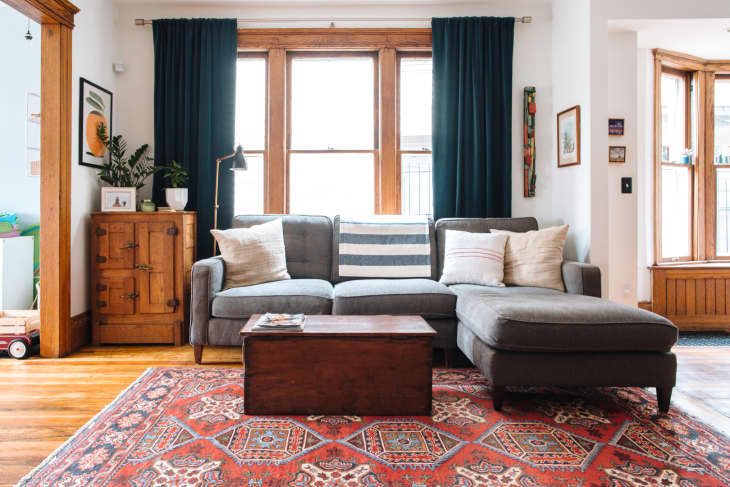9 Ways to Warm up Your Apartment If You Don’t Control the Thermostat

When the temperature dips and you’re ready to get your hygge on, an ice-cold apartment with no thermostat in sight can really kill the mood. Luckily, though, you have options (other than piling on the layers and wrapping yourself in every blanket you own).
The first thing you should do is put in a call to your landlord, since there are often regulations about what sort of heat they are required to provide. For example, in New York City, building owners must provide tenants with at least 68-degree heat between 6 a.m. and 10 p.m. if the temperature outside hits 55 degrees or below; between 10 p.m. and 6 a.m., the inside temperature must be at least 62 degrees.
If your landlord is unresponsive — or you simply like your unit a bit warmer than the required temperature in your area — there’s still hope. Here’s how you can help keep your space as toasty as possible.
Rearrange your furniture.
A radiator that’s blocked by furniture won’t do much to heat up a cold room. Move your furniture so that your heater is unobstructed; if that’s not possible, then make sure there’s at least six inches between your heater and any furniture to encourage airflow.
Cover bare floors.
A lack of insulation between floors accounts for about 15 percent of heat loss, according to Rise. To help keep that warm air where you want it to be (in your unit!), here’s a quick shortcut: add rugs. Cover bar floors with an area rug, or layer rugs for even more coverage. As a bonus, a little cushion underfoot will also keep your toes warmer while you’re walking around.
You likely have rugs in your living space and bedroom, but don’t forget the kitchen and bathroom, too. Rug grips can help keep them in place on slippery surfaces like wood and tile.
Turn your fan on reverse.
Switching your overhead fan on may seem counterintuitive, but flipping the switch on the motor and running it in reverse can actually help keep your space warmer for longer. How does it work, exactly? In its usual counterclockwise state, a fan’s blades will push cool air downward. Since warm air rises, when set clockwise, the spinning blades work to push any hot air down into the colder air below.
Install a door sweep.
If your exterior door has a slight gap, chances are excess heat is escaping your unit this way. Your best bet for this fix is a door sweep, which will help cover that gap and keep warm inside (and cold air out). These easy-to-install barriers cost less than $10 and not only help seal in any heat, but also can help protect your space from dust, insects, rodents, and even moisture.
If you’re nervous about putting holes in the door to install a permanent sweep, there’s an easy and affordable alternative: draft stoppers. Unlike door sweeps, these aren’t at all permanent; they’re basically long, heavy pillows that help block warm air from escaping (or cold air from getting in). While you can buy one for about $20, you can also make a DIY version by rolling up a few towels to place at the bottom of doors.
Add weatherstripping.
Adding weatherstripping around doors and window frames helps take care of air leaks in those spots. Note that you’ll need to open the window or door to apply weatherstripping around the edges of the frame, so it’s best not to save this project for the coldest night of the year.
Different materials and thicknesses can help accomodate the type of window you have and the gap you’re trying to fill; measure the width of your door or window frame and the size of the gap before buying. Wipe surfaces clean before applying the weatherstripping to help it adhere as firmly as possible.
Insulate your windows.
Many older buildings’ windows just aren’t as energy-efficient (read: insulated) as newer ones. You might not be able to replace your own windows — nor would you want to, considering new windows can cost thousands of dollars — but you can still shore them up. Help make up for the lack of insulation by covering windows with a removable film that helps block airflow to keep warm air in and cold air out.
Invest in thermal curtains.
If you have flimsy or sheer window treatments, swap them for something heavier. Look for insulated or thermal curtains, which not only keep the light out, but also serve to help insulate the room.
You don’t need to confine curtains to just windows, either. To help keep warm air from escaping, try mounting heavy curtains over exterior doors or in any interior open doorways.
Address drafty electrical outlets.
Wherever there are gaps in the wall, warm air can escape and cold air can make its way in — and this includes areas around your electrical outlets. Outlet insulation is an easy and cheap fix. All you’ll need to do is pop the outlet cover off, place the foam around the outlets, and screw the cover back on.
Run a space heater.
Of course, you can always switch on a standalone heat source, like a space heater. Just be sure to follow two important rules: Always place the space heater at least three feet from anything potentially flammable, and always run it only when you’re home and awake. As an added precaution, look for models with safety features such as automatic shut-offs, anti-tip designs, guarded coils, and timers.